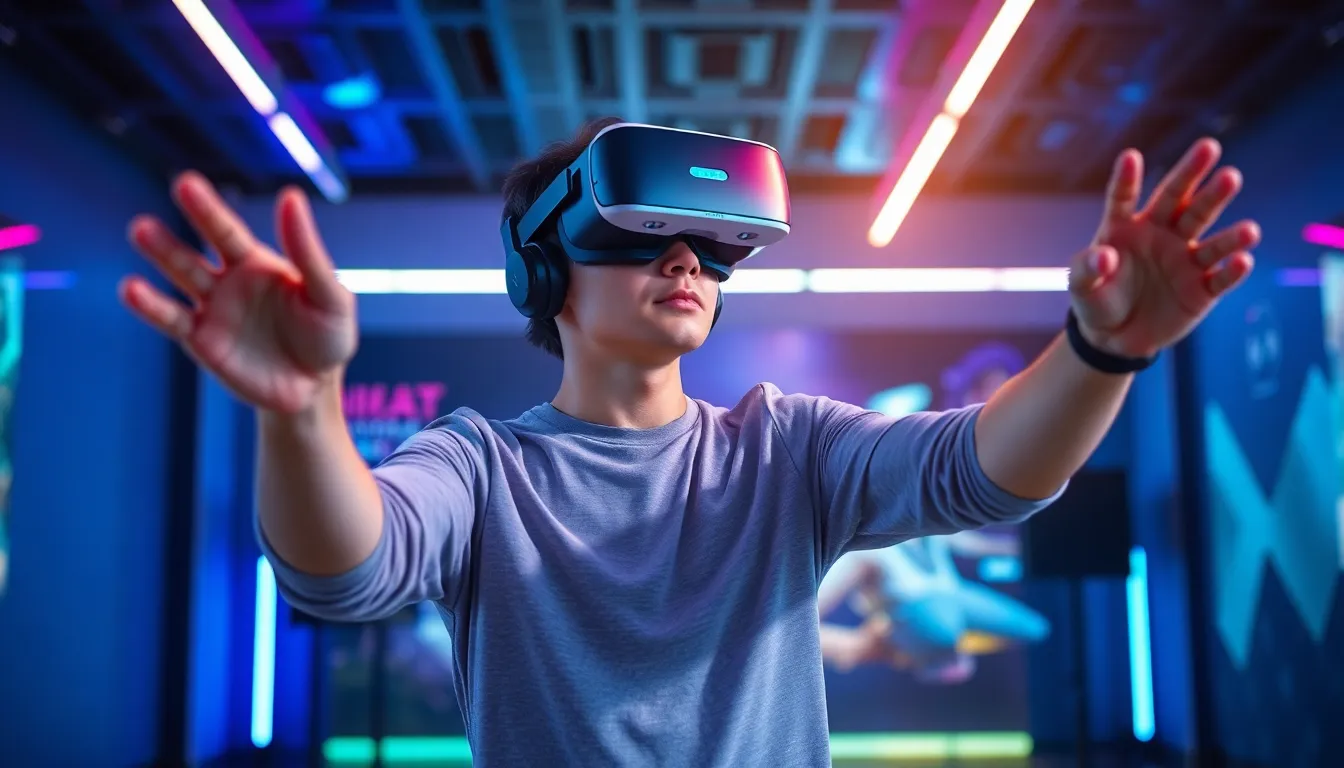Imagine diving into a virtual world where the only limit is your imagination—and your Wi-Fi connection. VR cloud gaming is shaking up the gaming landscape, allowing players to experience stunning graphics and immersive gameplay without the need for bulky hardware. It’s like having a high-end gaming rig in the cloud, ready to whisk you away to fantastical realms faster than you can say “lag-free experience.”
Table of Contents
ToggleWhat Is VR Cloud Gaming?
VR cloud gaming delivers immersive gaming experiences by leveraging cloud technology. Players access games streamed directly from the cloud, eliminating the need for powerful local hardware.
Definition and Overview
VR cloud gaming combines virtual reality with cloud computing. Through this technology, game data resides on remote servers, while video feeds transmit to players’ devices. Users wear VR headsets to immerse themselves in rich environments. Instant gameplay begins without lengthy downloads or installations when accessing titles from the cloud. Gamers can enjoy high-fidelity graphics and seamless performance, making it an appealing option for both casual and hardcore enthusiasts.
How It Differs from Traditional Gaming
Traditional gaming relies on local consoles or PCs for rendering graphics and processing data. In contrast, VR cloud gaming offloads these tasks to powerful cloud servers. This approach reduces the need for frequent hardware upgrades and setup complexities. Gamers experience real-time interactions without latency issues when connected to high-speed internet. Accessibility expands as users can play on various devices, from smartphones to dedicated VR systems, making it easier to dive into immersive worlds.
Benefits of VR Cloud Gaming

VR cloud gaming offers numerous advantages that enhance the gaming experience. Players access high-quality games instantly and enjoy immersive worlds without the barriers of traditional gaming setups.
Accessibility and Convenience
Accessibility becomes a key benefit of VR cloud gaming. Players engage with games on various devices, from smartphones to dedicated VR systems, ensuring flexibility. Convenience also plays a significant role, as there’s no need for lengthy downloads or updates. Players dive into gameplay immediately, enjoying a seamless transition between devices. Furthermore, the ability to play anywhere with high-speed internet opens opportunities for on-the-go gaming, catering to busy lifestyles.
Cost-Effectiveness
Cost-effectiveness stands out in the realm of VR cloud gaming. Gamers skip hefty investments in high-end hardware, as powerful servers manage processing and rendering. Subscription models often lower financial barriers, allowing players to access a vast library of games for a set fee. Reduced costs associated with hardware upgrades contribute further to savings. Also, the potential for accessing the latest titles without purchasing new consoles provides added financial relief. Overall, VR cloud gaming presents a budget-friendly alternative to traditional gaming methods.
Challenges and Limitations
VR cloud gaming faces several challenges that can affect the overall gaming experience. While it offers many advantages, some limitations need consideration.
Internet Speed Requirements
High-speed internet plays a crucial role in VR cloud gaming. A minimum download speed of 25 Mbps is often recommended for optimal performance. Insufficient bandwidth can lead to problems such as buffering and lower visual quality. Players accessing games may experience subpar graphics if their internet connection isn’t robust enough. Various factors, including network congestion and distance from servers, can impact speed. For consistent gameplay, maintaining a stable connection is essential.
Latency and Performance Issues
Latency poses a significant challenge in VR cloud gaming. A delay of more than 20 milliseconds can disrupt immersive experiences, making interactions feel sluggish or unresponsive. Real-time responsiveness is critical in virtual environments, where timing influences gameplay. High latency can stem from various sources, such as server locations and the player’s internet connection quality. Performance may also suffer during peak usage times, affecting the quality of the gaming experience. Addressing these issues involves optimizing server locations and improving network infrastructure.
Major Players in the VR Cloud Gaming Market
Several companies lead the VR cloud gaming landscape, driving innovation and providing immersive experiences. Key players include NVIDIA, with its GeForce NOW platform, offering gamers access to a range of popular titles directly from the cloud. Google Stadia also stands out, delivering high-quality gaming without the need for powerful hardware. Sony’s PlayStation Now provides another option, allowing users to stream games seamlessly on PlayStation consoles. Microsoft has entered the market with Project xCloud, integrating Xbox Game Pass for extensive gaming options in a cloud environment. These companies shape the future of VR cloud gaming through their combined resources and platforms.
Key Companies and Platforms
NVIDIA’s GeForce NOW enables players to access a wide array of games on various devices. Google Stadia provides a user-friendly interface and impressive graphics capabilities. Sony’s PlayStation Now offers a substantial library of PlayStation games for streaming directly to consoles. Microsoft’s Project xCloud connects Xbox Game Pass with VR gaming, enhancing user experience significantly. Each platform exemplifies the flexibility and accessibility that VR cloud gaming promises, catering to diverse gaming preferences.
Emerging Technologies
Advancements in cloud technology enhance VR gaming experiences continuously. Latency reduction techniques improve responsiveness, ensuring immersive gameplay is less compromised. Edge computing optimizes performance by bringing data processing closer to users, significantly minimizing delays. Artificial intelligence algorithms refine graphics and adjust game environments in real-time, providing players with tailored experiences. These emerging technologies reinforce the VR cloud gaming market’s robustness, adapting to user needs and preferences effectively.
Future Trends in VR Cloud Gaming
VR cloud gaming continues to evolve, presenting exciting possibilities and advancements. The landscape is shifting as technology enhances user experiences and access to games.
Potential Developments
New advancements in cloud computing are expected to revolutionize VR gaming. Enhanced graphics rendering is likely to improve visual fidelity, providing more immersive worlds. Companies may utilize edge computing to decrease latency and boost performance. Innovations in 5G networks could enable smoother gameplay by offering faster data transfers. Advanced AI algorithms might personalize game experiences, tailoring content to individual preferences. Server locations might expand, improving accessibility for players worldwide.
Predictions for Growth
Growing user adoption suggests VR cloud gaming could see significant market expansion. By 2025, the global market for cloud gaming may reach over $3 billion. Subscription services are anticipated to increase, offering gamers affordable access to extensive libraries. Partnerships among technology firms can drive competition, leading to improvements in user experience. Gamers are likely to prioritize convenience and access, contributing to steady growth. Increased interest from content creators may also lead to a wider variety of VR experiences on cloud platforms.
VR cloud gaming is set to redefine how players engage with their favorite titles. By eliminating the need for expensive hardware and lengthy downloads it opens up a world of immersive experiences. The combination of high-quality graphics and real-time interactions makes gaming more accessible and enjoyable for everyone.
As technology continues to evolve the future looks bright for VR cloud gaming. With advancements in cloud computing and the rollout of 5G networks gamers can expect smoother experiences and a broader range of options. The industry’s growth signals a shift toward more inclusive gaming environments where anyone can dive into virtual worlds without barriers. The excitement surrounding this innovation is just beginning to unfold.








